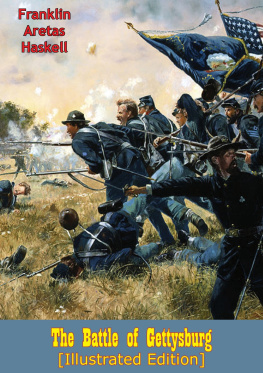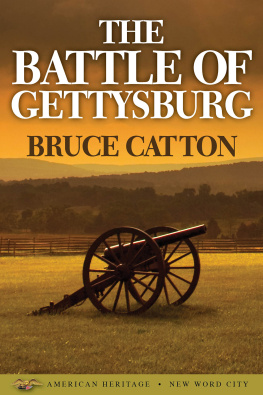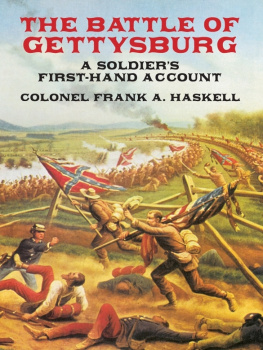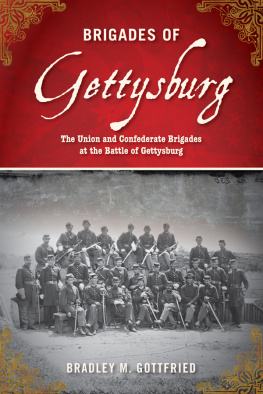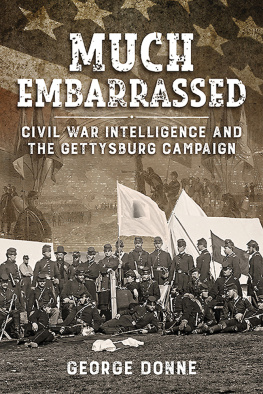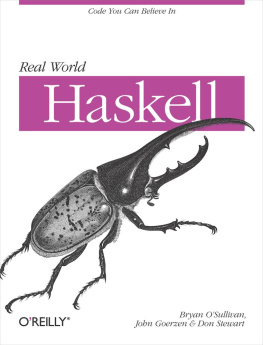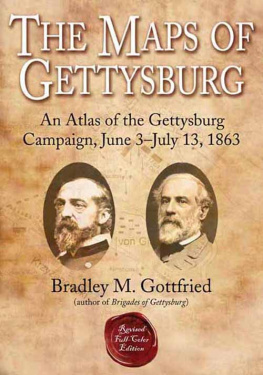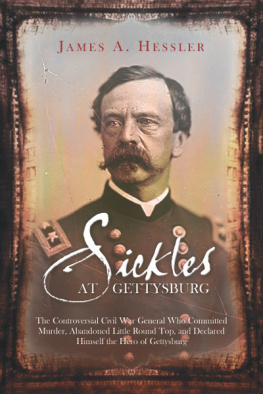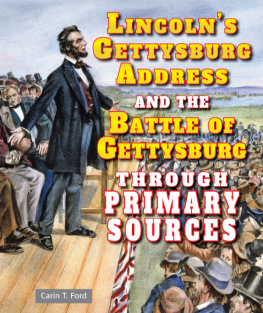

This edition is published by PICKLE PARTNERS PUBLISHINGwww.pp-publishing.com
To join our mailing list for new titles or for issues with our bookspicklepublishing@gmail.com
Or on Facebook
Text originally published in 1908 under the same title.
Pickle Partners Publishing 2016, all rights reserved. No part of this publication may be reproduced, stored in a retrieval system or transmitted by any means, electrical, mechanical or otherwise without the written permission of the copyright holder.
Publishers Note
Although in most cases we have retained the Authors original spelling and grammar to authentically reproduce the work of the Author and the original intent of such material, some additional notes and clarifications have been added for the modern readers benefit.
We have also made every effort to include all maps and illustrations of the original edition the limitations of formatting do not allow of including larger maps, we will upload as many of these maps as possible.
THE BATTLE OF GETTYSBURG
BY
FRANK ARETAS HASKELL
Aide-de-camp to General John Gibbon, and Colonel of Thirty-sixth Wisconsin Infantry

TABLE OF CONTENTS
Contents
ILLUSTRATIONS
Portrait of Author, while Colonel of Thirty-sixth Wisconsin Infantry
Map of Battle of Gettysburg, July 2
Map of Battle of Gettysburg, July 3
WISCONSIN HISTORY COMMISSION
(Organized under the provisions of Chapter 298, Laws of 1905, as amended by Chapter 378, Laws of 1907)
JAMES O. DAVIDSON Governor of Wisconsin
FREDERICK J. TURNER Professor of American History in the University of Wisconsin
REUBEN G. THWAITES Secretary of the State Historical Society of Wisconsin
HENRY E. LEGLER Secretary of the Wisconsin Library Commission
CHARLES E. ESTABROOK Representing Department of Wisconsin, Grand Army of the Republic
Chairman , Commissioner Estabrook
Secretary and Editor , Commissioner Thwaites
Committee on Publications , Commissioners Legler, Thwaites, and Turner
PREFACE
Frank Aretas Haskell was born at Tunbridge, Vermont, the son of Aretas and Ann (Folson) Haskell, on the 13 th of July, 1828. Graduating from Dartmouth College with distinguished honors, in the class of 1854, the young man came to Madison in the autumn of that year, and entered the law firm of Orton, Atwood & Orton. His career in this profession was increasingly successful, until in 1861 it was interrupted by the outbreak of the War of Secession.
Commissioned on June 20 of that year as First Lieutenant of Company I of the Sixth Wisconsin Volunteer Infantry of the Iron Brigade, he served as Adjutant of his regiment until April 14, 1862. Contemporaneous accounts state that much of the excellent discipline for which this regiment was distinguished, was due to his soldierly efforts during its organization.
He was called from the adjutancy of the Sixth to be aide-de-camp to General John Gibbon, when the latter assumed command of the Iron Brigade, and remained in such service until (February 9, 1864) he was promoted to be Colonel of the Thirty-sixth Wisconsin. While aide to General Gibbon he was temporarily on the staffs of several other generals, including Edwin V. Sumner and G. K. Warren, and won wide repute as a soldier of unusual ability and courage. With the Iron Brigade, he participated in the campaigns of the Army of the Potomac, taking part in reconnaissances at Orange Court House and Stephensburg, in skirmishes at Rappahannock Station and Sulphur Springs, and in the battles of Gainesville, Second Bull Run, South Mountain, Antietam, Fredericksburg, Chancellorsville, and Gettysburg. Reporting upon the battle of December 13, 1862, at Fredericksburg, General Gibbon alluded to his favorite aide as being constantly on the field, conveying orders and giving directions amid the heaviest fire.
Writing of Gettysburg, which is herein so graphically depicted by Haskell, General Francis A. Walker, in his History of the Second Army Corps , refers to our author as one who was bravest of the brave, riding mounted through an interval between the Union battalions, and calling upon the troops to go forward. He further says: Colonel Frank A. Haskell, of Wisconsin, had been known for his intelligence and courage, for his generosity of character and his exquisite culture, long before the third day of Gettysburg, when, acting as aide to General Gibbon, he rode mounted between the two lines, then swaying backward and forward under each others fire, calling upon the men of the Second Division to follow him, and setting an example of valor and self-devotion never forgotten by any man of the thousands who witnessed it.
General Winfield S. Hancock, officially reporting upon the battle, thus alluded to Haskells deed: I desire particularly to refer to the services of a gallant young officer, First Lieutenant F. A. Haskell, aide-de-camp to Brigadier-General Gibbon, who, at a critical period of the battle, when the contending forces were but 50 or 60 yards apart, believing that an example was necessary, and ready to sacrifice his life, rode between the contending lines with a view of giving encouragement to ours and leading it forward, he being at the moment the only mounted officer in a similar position. He was slightly wounded and his horse was shot in several places.
General Gibbons report said: I desire to call particular attention to the manner in which several of the subordinate reports mention the services of my gallant aide, Lieutenant F. A. Haskell, Sixth Wisconsin, and to add my testimony of his valuable services. This young officer has been through many battles, and distinguished himself alike in all by his conspicuous coolness and bravery, and in this one was slightly wounded, but refused to quit the field. It has always been a source of regret to me that our military system offers no plan for rewarding his merit and services as they deserve. In later years, the General again publicly alluded to Haskells heroic conduct on this field: There was a young man on my staff who had been in every battle with me and who did more than any other one man to repulse Picketts assault at Gettysburg and he did the part of a general there.
General William Harrow spoke of Haskell as having greatly distinguished himself by his constant exertion in the most exposed places.
Colonel Norman J. Hall, of the Michigan Seventh Infantry, and then commanding the Third Brigade, thus referred to the incident: I cannot omit speaking in the highest terms of the magnificent conduct of Lieutenant Haskell, of General Gibbons staff, in bringing forward regiments and in nerving the troops to their work by word and fearless example.
Upon receiving his appointment as Colonel of the Thirty-sixth Wisconsin, Haskell returned at once to this State, and recruited and organized the regiment for the field. Although his commission was dated from February 9, he was not mustered into service as Colonel until March 23. The regiment, which had been assigned to the First Brigade, Second Division of the Second Army Corps, left Madison May 10, and seven days later was acting as reserve during the battle at Spottsylvania. Its experiences thenceforth were of the most active character.
The command went into action at Cold Harbor, Virginia, early in the morning of June 3. The official account of what followed, is contained in the report of the State Adjutant General: The whole line advanced upon the enemy by brigades, in column closed in mass by regiments, the Thirty-sixth being in rear of the brigade. On advancing about three-fourths of a mile across an open field, under a heavy artillery fire, and when within about twenty-five rods of the rebel works, partially protected by the brow of a low hill, the Thirty-sixth was found in the advance, leading the brigade. During the advance, Colonel McKeen, commanding the brigade, was killed, when the command devolved upon Colonel Haskell. After a moments rest, Colonel Haskell, by command of General Gibbon, ordered the brigade forward. The men rose to obey, and were met by a shower of bullets, when the other parts of the line halted. Colonel Haskell surveyed the situation for a moment, as if irresolute; he finally gave the order, Lie down, men, which was at once obeyed. An instant afterwards, he was struck in the head by a rebel bullet, and instantly killed. Thus fell one of Wisconsins most gallant soldiers, a thorough disciplinarian, and an accomplished scholar.
Next page
